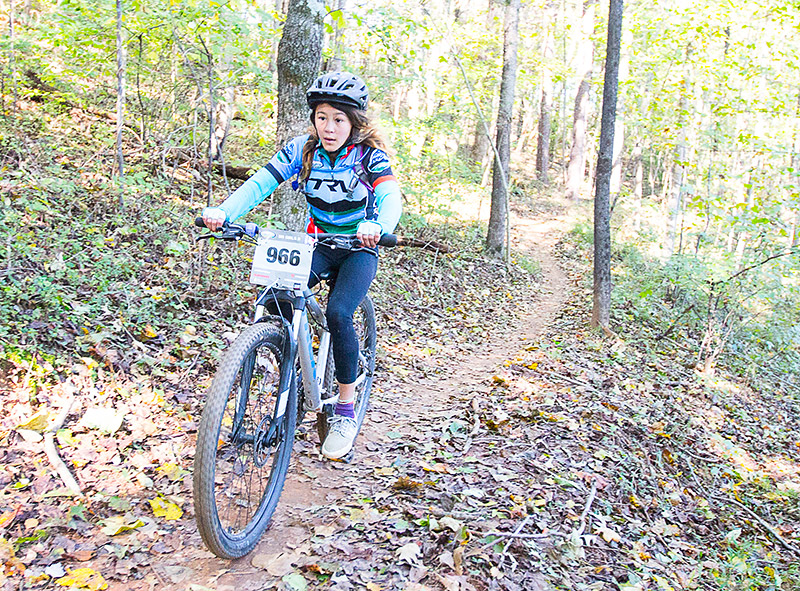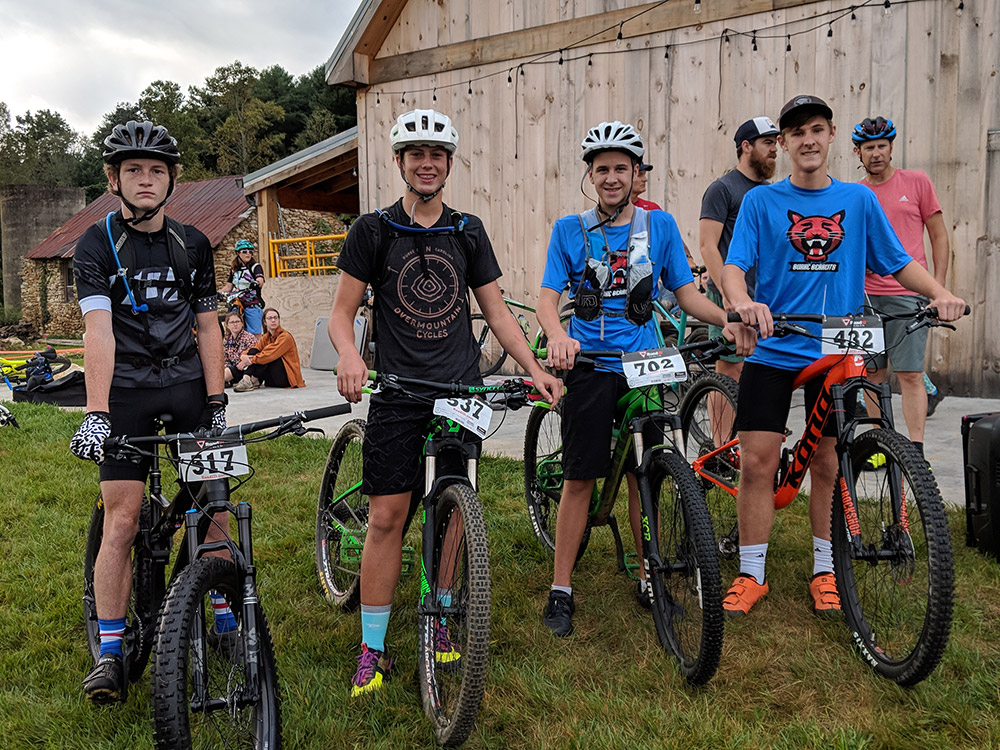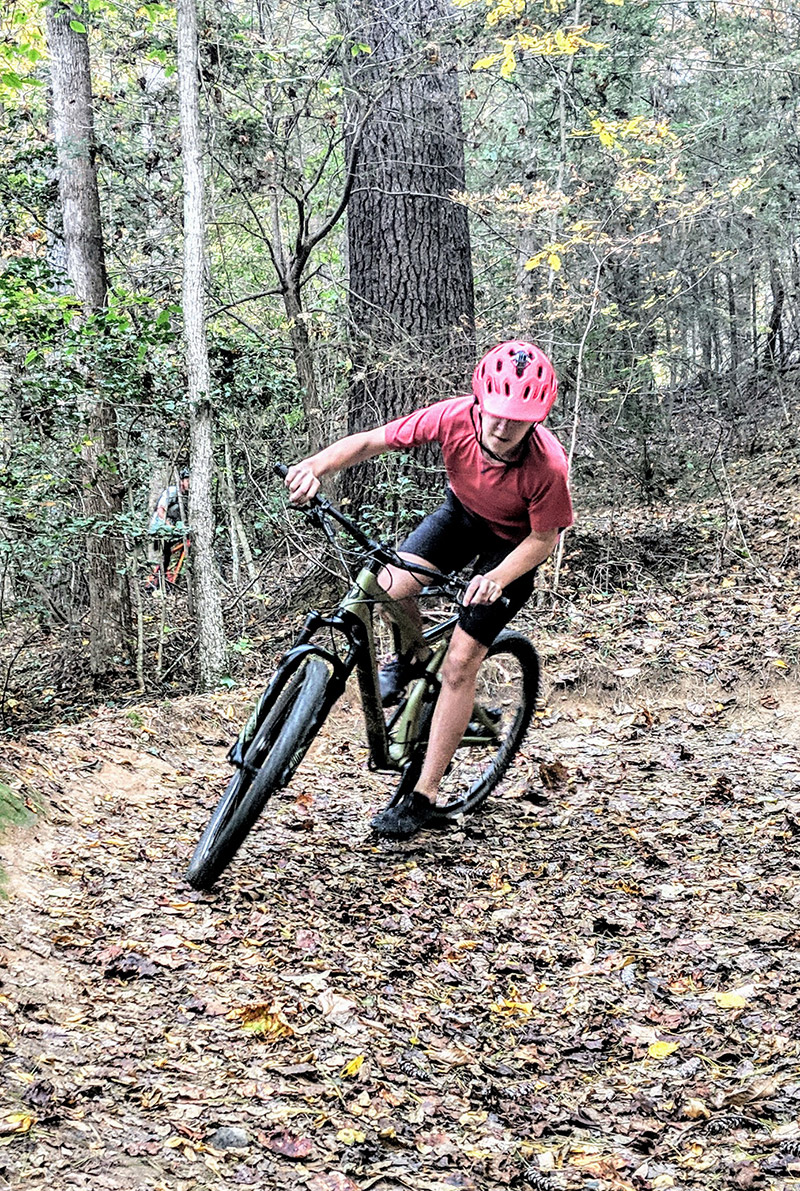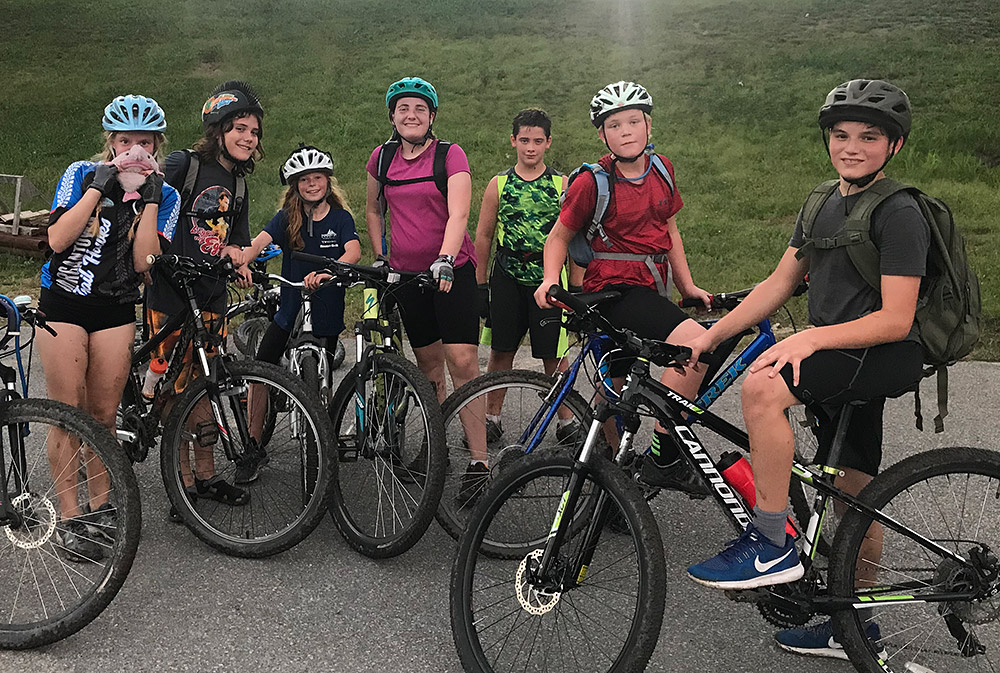Rise of Interscholastic Mountain Biking
By Eric J. Wallace

Middle school riders with the Burke BearCats, a N.C. Interscholastic Cycling League team, practice at a community college. Photo by Nikki Malatin
Converging upon team director Kevin Rogers, the kids are assigned trails according to skill level. He reads five to 10 names from a clipboard, followed by monikers like, “Smoke Tree Lane,” “Upper Homestead,” or “2,000 Hours.” Mounting their rigs, the kids follow parent-volunteers and coaches into the woods. Within minutes, they have disappeared.
What’s going on?
The Shen-Rock and Staunton-Augusta-Waynesboro youth mountain biking teams are practicing. For the next two hours, student-athletes will ride area trails working on skills like pacing, jumping and cornering. Gathering twice a week and racing on Saturdays, the teams are comprised of riders from Virginia’s Augusta and Rockingham counties. They spend at least eight hours per month installing and maintaining bike trails.

A New River Valley Middle School rider competes during the Virginia Interscholastic Cycling League’s October 2018 race in Bedford, Va. Photo by Jack Looney
The teams compete in the state’s two nationally sanctioned interscholastic racing leagues during the spring and fall: the Virginia High School Mountain Bike Series and the Virginia High School Cycling League, respectively. The former is a USA Cycling affiliate, the latter, an affiliate of the National Interscholastic Cycling Association. Together, the leagues incorporate more than 500 student-athletes, 400 coaches and 33 teams — including 14 fielded by public and private high schools. Both offer routes to racing in college or professionally.
According to Virginia High School Cycling League Director Andrea Dvorak, the sport gained a foothold in Southeast schools in 2010 and has since exploded in popularity.
“We’ve seen a 93 percent increase in enrollment in the past year alone,” she says, noting that the growth has not been isolated to Virginia. “In the past five years, leagues have proliferated throughout the East, particularly in Appalachia.”
Though Virginia and New York led the way, Georgia, Alabama, Tennessee, North Carolina, West Virginia, Maryland and Pennsylvania have adopted leagues as well. Participation has grown exponentially.

The Burke BearCats, a N.C. Interscholastic Cycling League Team, is in its second year. The Co-ed team includes public, private and homeschool students from Burke and Catawba counties. Photo courtesy of Head Coach Nikki Malatin
A case in point is North Carolina, which launched its NICA league in the spring of 2017 with 321 riders and 30 teams. Going into the 2019 season, NC League Director Mike Long says his ranks now include 623 student-athletes, 331 coaches and 39 teams.
“It’s incredible how fast we’ve grown,” he says. “And it’s getting bigger by the day. I wouldn’t be surprised if that number doubled within the next five years.”
From Hogwarts to Public Schools
How did interscholastic mountain biking get started in Appalachia? Oddly enough, with a high school English teacher.
When Peter Hufnagel accepted a position at Virginia’s private Miller School of Albemarle in 2009, NICA had just been founded in California. Seeking to turn mountain biking into a sanctioned high school sport, the organization offered a blueprint for programs that could be adapted anywhere in the nation. They provided training, vetting and certification for coaches, trail-building clinics, scheduling templates, standardized rule books, mentorship resources, and, most importantly, insurance.
The development piqued Hufnagel’s interest. In addition to being a former standout cyclist at the University of Virginia and a semi-pro racer, he was (and remains) married to Dvorak, who was then riding both professionally and for Team USA.
The Miller School was located just miles from the Blue Ridge Parkway and Shenandoah National Park. “I’d raced around the world and was blown away by the area’s trails and roads,” he says. “It seemed logical we should create a team and leverage those resources to put it on the map.”
But what Hufnagel had in mind was more than a team; he aimed to build a “Hogwarts” for high school cyclists.
“I understood the realities of a young person with professional ambitions,” he explains. Races could be hundreds or even thousands of miles away. Academic support was minimal, and finding peers, virtually impossible.
“These kids are often the only ones this into bikes within a 150-mile radius,” says Hufnagel. “I thought, ‘Why not give them a home? We could provide Olympic-level coaching and training, transportation to events and an unparalleled education.’”

Miller School of Albemarle students build trails during a service day at school. Photo by Jack Looney
But fielding a legitimate high school racing team required competition, and it had to have weight. To attract serious riders, the program needed to be a conduit for collegiate and pro careers. Working with Dvorak and her coach at Team USA, Andy Guptill, Hufnagel put together a strategic plan and pitched both school administrators and USA Cycling. To his astonishment, they bought in.
In the spring of 2010, he and Dvorak launched the Virginia High School Mountain Bike Series. The Miller School was now home to the East Coast’s first official high school mountain biking team and its only nationally sanctioned interscholastic racing series — but the learning curve was steep.
“That first season was about as grassroots as it gets,” says Hufnagel. “There were four teams and maybe 20 riders. [Miller School of Albemarle] fielded just three racers!”
Yet, there was cause for excitement. With Dvorak and Guptill looking to retire from professional racing, Hufnagel convinced them to accept teaching and coaching positions at the Miller School.

A student on North Carolina’s Burke BearCats team enjoys a pre-season ride. Photo courtesy of Head Coach Nikki Malatin
Subsequently, the Virginia High School Cycling League was established in early 2014. Races were held that fall. Though series’ participants initially mirrored the VAHS, that soon changed.
Backed by Dvorak, Charlottesville Area Mountain Biking Club President Sam Lindblom approached Monticello High School Athletic Director Matt Pearman in the spring of 2015.
“Sam basically said, ‘My son is really into mountain biking and he has enough friends to make a team. What can we do?’” says Pearman. “As an [athletic director], my goal is to enable as many students to participate in sporting activities and represent their school as I can. So, when he explained about NICA, I got pretty excited. I knew this was something we needed to make happen.”
That fall, Monticello became the first public high school in the Southeast to field a mountain biking team. The move proved a tipping point. By 2016, riders had more than doubled league-wide.
“Getting into [Monticello] validated what we were doing and attracted a lot of attention,” says Dvorak. “Suddenly kids were saying, ‘If they have this, why can’t we?’”
Questions flooded in from throughout Virginia and beyond. By 2018, every high school in the Charlottesville area was fielding a team. Composite squads included riders from almost every county in the state. New NICA leagues were established in North Carolina, Maryland, Pennsylvania and West Virginia. Pearman became the go-to mountain biking contact for East Coast athletic directors.
Meanwhile, the Miller School’s program grew to include 50 world-class riders from around the globe. Entering its ninth year, the school has graduated four riders into the professional ranks. In 2017, 16-year-old junior Katie Clouse won national titles for both cross-country and short track mountain biking. This winter, she became the youngest rider to represent the United States at the World Cyclo-cross Championships.
Mountain Biking in the Mountain State
West Virginia launched its interscholastic mountain biking league in the fall of 2018. Director Carrie Smith says it took 18 months of hard work. Like Lindblom, her interest began at home.
“My son and I have been riding buddies since he was three,” she says. Though the 13-year-old raced with a composite team before Smith helped start the new league, events were infrequent at best. Competing for his school seemed unfathomable.
When Smith heard about the Virginia High School Cycling League in 2016, she decided to attend its annual summit. There, she met Dvorak and numerous coaches. Their camaraderie surprised her.
“It was all about getting kids on bikes and into the woods and having fun,” she recalls. “Of course, everybody wanted to put on a great race. But the competition element was secondary. This was more about community. They talked about introducing kids to wild spaces, and stewardship, and an active outdoor lifestyle. In that way, their goals were very different from a traditional sport like football or basketball.”
Smith returned to Morgantown, W.Va., energized. Phoning and emailing friends in the biking community, she scheduled an open meeting. More than 60 people attended.
“I couldn’t believe the level of interest,” she says. “By the end of the night, we’d formed planning committees and assigned tasks.”
By 2018, they had gained NICA certification. The league entered the season with nine region-based composite teams including 130 riders and 100 coaches. By the third race, parents were phoning in droves.
“The kids assumed total ownership of this,” says Smith. “They were proud of what they were doing and talked it up at school with their friends. Parents called and I encouraged them to bring their kids to a practice. We had new guys and gals coming out nearly every week.”
If a kid showed interest, but didn’t have money for a bike, Smith put the word out to sponsors and coaches. In three separate instances, bikes were made available within a week.
“One of NICA’s big missions is getting kids on bikes, regardless of economic background,” says Smith. “And this is a very supportive community.” In one case, a local bike shop provided a ride for the season. In another, a team parent donated a spare rig. “If a kid wants to ride, we’re going to make it happen, period,” asserts Smith.
Heading into the spring, Smith has registered an additional three teams and 120 riders. What’s more, she was contacted by 10 state parks inquiring about sponsorship and trail-building opportunities. Five have offered to install NICA-approved racing trails.
“Park superintendents see this as the next big thing,” says Smith. In addition to riding skills, coaches teach mandatory lessons on stewardship and sustainable trail maintenance. “Officials have told me it’s like an unexpected dream come true,” she laughs. “Suddenly all these kids are itching to explore the woods on bikes. The parks want to encourage that trend.”
Looking back on the past two years, Smith says it’s been a whirlwind journey. But when she sees the kids’ excitement, she knows the investment has been worthwhile.
“Many of these kids had never stepped foot in the woods before,” says Dvorak. “And now they’re riding and helping to install professional-quality trails in some of the most beautiful forests in Appalachia. Mountain biking has introduced them to a new kind of lifestyle—one that centers around healthy activity in the outdoors.”
Better still, more and more are doing it in conjunction with their schools.
Teaching Kids to Build Bikes in Tennessee
Mountain biking can have a steep cost of entry. A basic hardtail rig retails around $450 — used, they can be found for half that — and the dual-suspension models that advanced riders favor can be hundreds of dollars more. Many families can’t afford the investment. This has league directors looking for ways to ensure interested students can ride, regardless of economic background. In Nashville, Tenn., Dan Furbish has developed a novel approach.
Working as a counselor at the community-based Oasis Center in 2009, he stumbled upon research citing the benefits of bikes for at-risk inner-city youths.
“The idea was, if you give kids with a problematic homelife personal transportation, they’ll use it to access positive community resources,” says Furbish. “I thought, ‘Why not take the idea a step further and teach them to build their own bikes?’”
He launched the experimental Oasis Bike Workshop that summer, and about a dozen kids signed up. Halcyon Bike Shop provided tools, old bikes and spare parts. Health insurance company Humana, Inc., offered funding for tires, tubes and so on. Furbish provided the mechanical knowhow.
The approach was two-pronged. On one hand, the kids would learn new skills and gain access to transportation. On the other, they would bond with peers in a mentorship environment. Furbish hoped the latter would lead to greater participation at Oasis.
As it turned out, the program was a hit — the center became a kind of second home for many. When more kids inquired about signing up, the workshop was made a year-round offering. Furbish has since helped to put more than 500 kids on bikes.
In 2015, a handful of students asked about starting a mountain biking team. Learning about Tennessee’s NICA league, Furbish said yes. Adapting a similar do-it-yourself approach, he helped the kids secure sponsorship from local businesses and build racing rigs.
“At first we were like the Bad News Bears,” he says with a laugh, noting that the bikes sometimes broke down. As time progressed, though, they worked on skills and acquired additional sponsors.
“They became better racers, built better bikes, got new jerseys,” continues Furbish. “It was an incredible transformation. And they did it almost entirely on their own.”
Related Articles
Latest News

Leave a comment
Your email address will not be published. Required fields are marked *






Leave a Comment